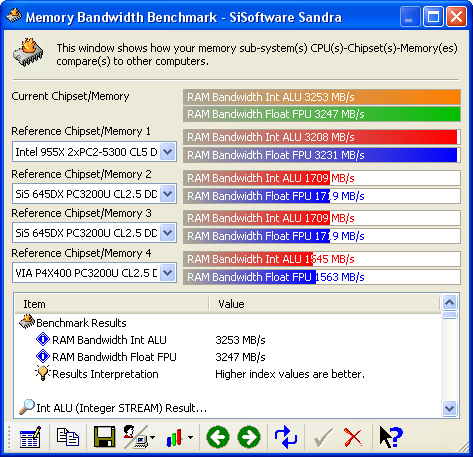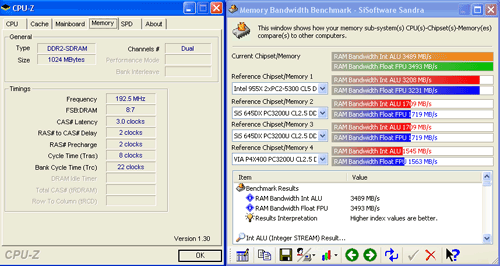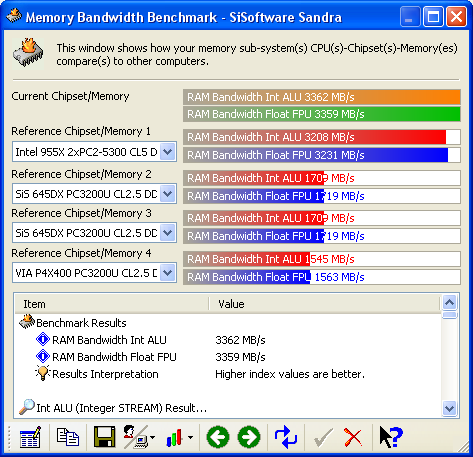Abit NI8 SLI: nVidia SLI for the Intel Gamer
by Randi Sica & Wesley Fink on October 7, 2005 12:05 AM EST- Posted in
- Motherboards
ABIT NI8 SLI: Memory Overclocking
Each generation of boards and chipset technology often comes with even greater opportunities to increase a board's bandwidth and performance through overclocking of the memory. Of course on Intel boards, the optimum scenario is usually one in which the FSB and memory speeds are 1:1 with the tightest timings possible. Increasing memory speed beyond the FSB speed yields not much gain, and more or less, it is left for bragging rights in the ability of a mainboard and/or CPU to push its ram into the stratosphere. In many cases, to achieve ultra high memory speed, you must reduce timings and latency to such an extent that bandwidth begins falling off considerably.
We'll start with our baseline Corsair at the previous DDR2 667 MHz 3-2-2-8 1T timings. All Sandra bandwidth is measured unbuffered.
The next progression upwards was over the 800 MHz mark. In order to attain 807 MHz memory speed, it was necessary to drop 1T command to 2T. This increase in latency can and does result in major drops in bandwidth that may not look substantial in bandwidth test numbers, but can reflect a big difference in gaming fps performance, for instance. The Ras to Cas delay and Ras precharge also had to be dropped a notch to 3. As you'll notice, compared to the previous example of 770 MHz using tighter timings, bandwidth has tailed off slightly by a little over 100MB/s.
Each generation of boards and chipset technology often comes with even greater opportunities to increase a board's bandwidth and performance through overclocking of the memory. Of course on Intel boards, the optimum scenario is usually one in which the FSB and memory speeds are 1:1 with the tightest timings possible. Increasing memory speed beyond the FSB speed yields not much gain, and more or less, it is left for bragging rights in the ability of a mainboard and/or CPU to push its ram into the stratosphere. In many cases, to achieve ultra high memory speed, you must reduce timings and latency to such an extent that bandwidth begins falling off considerably.
We'll start with our baseline Corsair at the previous DDR2 667 MHz 3-2-2-8 1T timings. All Sandra bandwidth is measured unbuffered.
The next progression upwards was over the 800 MHz mark. In order to attain 807 MHz memory speed, it was necessary to drop 1T command to 2T. This increase in latency can and does result in major drops in bandwidth that may not look substantial in bandwidth test numbers, but can reflect a big difference in gaming fps performance, for instance. The Ras to Cas delay and Ras precharge also had to be dropped a notch to 3. As you'll notice, compared to the previous example of 770 MHz using tighter timings, bandwidth has tailed off slightly by a little over 100MB/s.













19 Comments
View All Comments
TheInvincibleMustard - Saturday, October 8, 2005 - link
Thanks for clearing that up, Wesley ... here I was thinking that AT had gone off their rockers for a moment :D-TIM
jojo4u - Friday, October 7, 2005 - link
A new Forceware was also used in the gaming tests.smn198 - Friday, October 7, 2005 - link
Agreed. This is not a motherboard test.TheInvincibleMustard - Friday, October 7, 2005 - link
QFT ... what's the point in testing a new board while conveniently slipping a new processor into it as well? That's akin to "Let's compare this Accord versus this Corolla, oh and by the way, the Accord has nitrous, aftermarket shocks, aftermarket brakes, aftermarket muffler ..."Thanks for an article that shows that dual-core is better than single-core in multi-threaded applications ... funny, I thought Anandtech did one of those articles a while back ...
-TIM
PS -- WTF is up with no Firewire on this board? Mobos http://www.newegg.com/Product/Product.asp?Item=N82...">less than $80 shipped have IEEE1394 connectivity for cryin' out loud ...
TheInvincibleMustard - Friday, October 7, 2005 - link
Err ... well ... I tried to QFT, but apparently it didn't work? Whatever, I still agree with you guys.-TIM
ksherman - Friday, October 7, 2005 - link
Man, I REALLY like the passively cooled chipset... wish DFI did that in the nF4 boards...mongoosesRawesome - Friday, October 7, 2005 - link
eh, not so impressed myself. what ABIT did looks expensive and it doesn't get the job done adequately. DFI includes temperature controlled fans in their BIOS, which makes their fans bearable. A nice thing about Nforce 3/4 boards is that you really only have one chip to cool.Who exactly is Abit targeting with this board? Who games with Intel? A64s are cheap, nforce 4 boards are cheap, and they perform better. I realize that in the corporate world, there are people out there that only use Intel, but I figured gamers were different. I just can't see this board really being that popular.
KristopherKubicki - Friday, October 7, 2005 - link
ASUS did it first with the "Premium" series stuff.Kristopher
emc2-1955 - Sunday, August 29, 2010 - link
I got an Abit NI8 SLI with an extreme processor and 4 gig of ram. The problem is that to takes forever to load. I've tried it with windows xp pro and windows 7 can anyone tell me what I chould check any tips